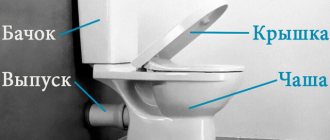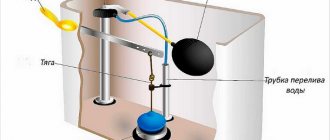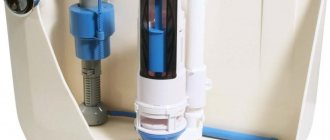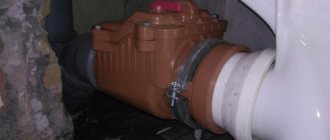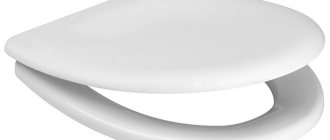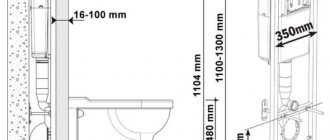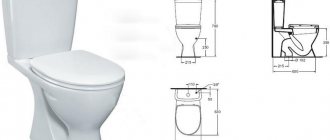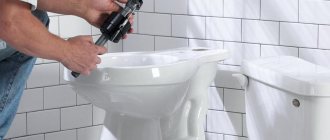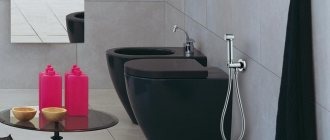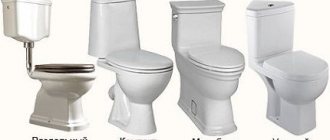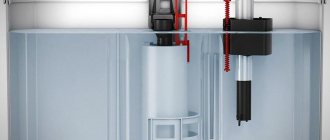What types of toilets are there?
Basically, toilets are distinguished according to the principle of fastening: floor-mounted, wall-hung and attached.
A wall-hung toilet takes up little space, but is quite difficult to install
Classic flooring options come in a variety of shapes, and there is plenty to choose from in this category. Basically, the tank is mounted directly on the seat, but there are also models with a separate tank located a little higher. The cast design, in which the tank and bowl are one piece, eliminates the need for the owner to periodically repair the tank and change the rubber cuff.
Advantages of floor-mounted plumbing:
- simple and convenient design;
- installation is carried out without complications;
- reasonable prices.
Flaws:
large dimensions. Small selection of compact models.
Wall-hung toilets have come into fashion relatively recently. While widely used in Europe, suspended structures are rare in domestic bathrooms. They are distinguished by the absence of legs and are attached to the wall using anchor bolts. The toilet tank is not visible; it is installed in a false wall.
Design advantages:
- stylish, elegant and compact. An ideal option when there is a shortage of square meters;
- variety of models;
- ease of cleaning.
Disadvantages of the hanging option:
- high price;
- complex installation.
An attached toilet is a hybrid of a floor-mounted and wall-hung one. The bowl is mounted on a leg, like a traditional toilet, and the tank is hidden in the wall, like a floor-standing one. This option has few fans, so the range of attached models is not wide.
The cistern of the attached toilet is hidden in the wall
This is interesting: Corrugation for the toilet - dimensions, installation, how to change, types
How is a free-standing toilet installed?
Installation of this product must be carried out in certain stages:
- Selecting a device in accordance with all user preferences.
- Applying markings, and during this process it is important to take into account the dimensions and other parameters of the toilet itself, as well as the drain pipe or the cuff used during the installation process.
Toilet cuff during installation - A cuff is put on the outlet of the product, after which it is installed in the place where it is intended to be used constantly, and at the same time it is important to ensure that the cuff easily fits into the sewer pipe. During work, it is important to use silicone sealant to ensure the tightness of the joints being created. The safety and ease of use of the plumbing fixture depends on this.
- Fixing the toilet, which can be done using different methods. The canopy toilet can be attached using glue, cement mortar or various fasteners. Ordinary self-tapping screws can be used, and high-quality and reliable anchors or dowels can also be used. Before final fastening, it is important to use a level to make sure that the installation was completed correctly and in accordance with all requirements.
- If the work was carried out using fasteners, it is recommended to additionally treat the connection with glue or cement mortar for better installation.
- A hydraulic test of the functionality of the installed element, which will show whether there are any problems in it that can be immediately eliminated, and only then proceed to the constant use of the toilet.
Suspended modification with installation
The word “installation” in this case should be understood as the word “hide” or “conceal”. When talking about installing a toilet, we are talking about the structure and fastening elements of the toilet built into the wall. This toilet significantly saves space in the bathroom and looks very stylish and neat. For a small room this is the best option.
Compared to conventional toilets, wall-hung toilets have significantly more advantages:
- Maintaining hygienic cleanliness in the bathroom with such models is much easier. There is no need to constantly clean the toilet mounting points, as well as various cracks between the floor and plumbing.
- If a heated floor or expensive floor covering is installed in the bathroom, then they will not be affected during plumbing repairs.
- Due to the fact that everything unnecessary is hidden in the wall (fasteners, tank), and only the drain button remains visible, it looks minimalist and stylish.
A wall-hung toilet also has its disadvantages:
- High price;
- If repairs are necessary, it will be difficult to get to the tank or pipeline valves hidden in the wall.
Visor toilet with visor bowl - pros and cons of the design
The variety of earthenware sanitary products allows you to choose a design that best suits the parameters of a specific water supply and sewerage system, as well as the needs of each consumer.
In typical apartment buildings today, a canopy toilet is most often installed with a flush cistern mounted on a special canopy at the rear edge of the bowl. This design allows it to be built into a special niche to save space in the bathroom and improve the aesthetics of the interior.
The shape of the bowl in its structure is similar to a funnel-shaped one, however, its walls have an unequal angle of inclination: usually the back wall is flatter than the front, in some models it happens the other way around.
This shape of the visor toilet bowl ensures a neat and economical flush, as well as the absence of splashes and unpleasant odors. However, for some consumers, the disadvantage of the design is the dirty marks left on the walls of the bowl after defecation, which can be removed with a brush and repeated flushing.
No splashing
When choosing a toilet, the main condition for most buyers is the absence of water splashes.
Modern toilets mostly consist of a funnel-shaped bowl, when used, everything goes directly into the drain channel. This avoids unpleasant odors and reduces water consumption. The main disadvantage of such a bowl, as mentioned earlier, is the presence of splashes. This is something to keep in mind when choosing the best toilet. Modern models are designed with an anti-splash system and completely eliminate this problem for the user.
However, you need to carefully study the model and check whether this option really exists. In such models, the drain hole itself has a special structure. It is narrowed downward and directed to the side. The water is at the very bottom of the drain hole.
Toilets from popular brands
In the pre-perestroika period, visor toilets were not produced by the domestic industry, but were purchased abroad, as a rule, in Finland, which is why they are still sometimes called “Finnish”.
In them, as in dish-shaped toilets, the drain hole is located closer to the front, almost vertical wall, while the rear wall has a much flatter angle of inclination, which ensures high flushing efficiency even with a relatively small amount of water.
Toilet. Subtleties of choice.
Source
The drain is also different
If you have not decided to purchase a toilet with anti-splash, then pay attention to another factor that affects the amount of splashes. It's a kind of drain
Advice. If you want to try out fashionable new items, you can take a closer look at toilets with additional functions. This is an automatic drain for the forgetful, and a heated seat system for use in the cold season.
Classic floor-standing toilet
Direct drainage involves a powerful pressure of water in the direction from the tank to the drain hole. The disadvantage of this type is that the entire surface is not washed, which means you need to use a brush. In addition, it is this kind of drainage that leads to the formation of splashes.
With a circular drainage system, water moves in a spiral, which means it effectively cleans all surfaces. The disadvantages of this type are that toilets with a circular flush are much more expensive. In addition, they are combined with a narrow opening that can become clogged.
Specifics of the visor toilet
This product has some differences from standard toilets, and these include:
- The flush cistern of this plumbing product is mounted on a special visor located on the bowl of the toilet itself. This allows you to use such an unusual design technique, which involves hiding the tank in a niche that exists in the bathroom. In this case, you can significantly improve the appearance of the bathroom, and if you use an installation, the tank can be completely hidden.
- The shape of the bowl of such a product is specific. A toilet with a visor bowl is considered easy to use, since its principle of operation is very similar to the funnel shape, but it does not have the disadvantages of this design. The fact is that the bowl has a flat back wall, but the front is not so flat. This leads to the fact that during the use of the product, all fecal matter falls directly into the drain hole, but this does not result in a lot of unnecessary splashes.
- Due to correct and optimal flushing, quite significant water savings are ensured, and during use you can be sure that there will not be a lot of unpleasant odors. Therefore, a visor-shaped toilet is considered an excellent choice for any bathroom.
Accommodation
There are differences in plumbing models based on the type of installation, divided into three types.
Corner and classic models are available, placed next to the wall opposite the entrance. Both types are installed directly on the floor or on a stand. When secured with anchor bolts during installation, it is easy to dismantle the equipment, replacing old with new without causing damage to the floor covering.
Models with an attached skirt do not affect the functionality of the design. It is an aesthetic element created by designers. When doing wet cleaning, do not touch the plumbing equipment with the rag.
Corner floor
Installation is carried out in a standard way. The corner structure is distinguished by the shape of the barrel, which fits in the center of the junction of two wall panels.
Wall or hanging
During installation, a plate is used that is built into the side panel of the toilet. The work is done by professionals. The equipment is secured to the slab in the wall with anchors. Such models are in demand in Europe, but in our country they are rare.
Advantage:
- Easier to clean the toilet.
- Saving space.
- Stylish design
You need to purchase plumbing fixtures after you have become familiar with all types of drains, installation methods and functional features. Choosing the right toilet from quality material will make it easier to care for. Having set anti-splash as a criterion, they understand that the price for such a product is high. This will be affected by the shape of the bowl and the flushing device.
The shape of the splash-free toilet is the same for all models. It has an internal rim that holds back the flow of water leaving the barrel under pressure. If the seller talks a lot of interesting things about a special device in order to sell an expensive illiquid product, then this is not the main thing. It is advised to find plumbing equipment with a suitable bowl equipped with a protective barrier from the inside. Video: Features of choosing a wall-hung toilet
Only a properly selected toilet can be considered comfortable. The choice of new plumbing is influenced not only by convenience, appearance and price
It is important that the toilet fully copes with its main function - it flushes well and does not splash. How to choose just such a toilet?
How to care for the element?
The visor shape of the toilet bowl is considered very comfortable and pleasant to use, but even it needs to be properly looked after so that the device itself lasts long enough and also maintains its desired parameters all the time. It is important to constantly wash off and remove all dirt after each use, and periodically use various detergents with brushes to clean all the walls of the product. If leaks or cracks are detected in the tank or on the toilet itself, it is important to begin repairs immediately so as not to aggravate the situation by inaction. In this case, you can expect a long service life of the installed plumbing fixtures.
Source
Flush
How to choose a toilet that flushes well? This, by the way, is a very important condition. A good toilet should flush efficiently
There are two options for draining water:
- Cascade. This flush occurs from one hole in the toilet bowl. This option is uneconomical in terms of water consumption, since flushing occurs with a strong pressure of a large amount of water. These models are good for their budget price and reliability. A significant disadvantage is the lack of hygiene, since the stream of water cannot cover all areas of the toilet bowl. Also, rust very often appears on such bowls.
- Shower. This is undoubtedly the best option. A more modern toilet flush design allows for greater hygiene. Water washes the bowl from holes around the entire perimeter. At the same time, water consumption is quite economical. It must be said that models with shower flush are more expensive than cascade models. But it’s not worth saving on this.
https://youtube.com/watch?v=MQpz6qNWNTw
Choosing a toilet
Types of toilets by bowl
The shape of the bowl must ensure comfort, hygiene and functionality. And although there are several basic geometric types, there are minor differences between different manufacturers that are not noticeable at first glance.
According to the bowl design, toilet bowls are:
Funnel-shaped
The advantage of the design is high hygiene due to the location of the funnel in the center of the bowl, which ensures thorough and instant removal of defecation products. Disadvantages include the possibility of a splash.
Disc-shaped
The design is a flat platform (shelf) for the accumulation of waste, which is cleaned only under the influence of a stream of water. Bowls of this type are considered obsolete, and although they prevent splashing, due to low hygiene they are rarely produced nowadays.
Visors
The most common form, the design of which includes a special protrusion that prevents the formation of a splash and a slope that ensures the removal of defecation products from the walls of the device.
In addition to operational parameters, the shape of the bowl should ensure thorough flushing, preventing the formation of salt deposits and splashing of water. These parameters are determined by the symbiosis of the bowl design and the type of flush.
Drain
If the user is going to install plumbing fixtures on his own, and is doing this for the first time, then it is still worth consulting with a qualified specialist about the nuances that you need to pay attention to when purchasing. After all, the design, location and slope of the drainage system is different everywhere, and in order not to have to worry about installing a piece of plumbing, you need to take care of this in advance by choosing a suitable model
The outlet necks for draining the tank are:
- Vertical. This option is perfect for small toilet rooms, because this design will allow you to attach the toilet as close to the wall as possible.
- Horizontal. This design is suitable for houses with horizontal sewer outlets.
- Angular. In such instances, water is drained at an angle.
How is this toilet connected to the sewerage system?
Round toilet
Connecting this device practically does not have any specific features from the same work that is carried out with other types of products. However, it is important to know exactly how to perform all the work correctly so that various problems do not arise during the use of this product.
Initially, it is important to know that even canopy toilets can be installed using different methods, so they can be divided into several types:
- Floor-standing varieties are the most popular and frequently used, and they can be located next to a specific wall or can even be installed in the middle of the room if necessary. A visor-type toilet is usually presented in this particular variety, and its installation and connection in this case are considered simple.
- Hanging ones are compact and beautiful, and most often they can be found in various public institutions, since they do not take up much space, and at the same time they are unusually interesting in appearance. Installing a wall-hung toilet is quite difficult, but if you wish, you can easily cope with this work if you know exactly all its nuances and specifics.
- Wall-mounted toilets are mounted exclusively next to a specific wall, and are also fixed to it and to the floor.
Having chosen a certain type of toilet, it is important to decide what kind of outlet it has. The fact is that for high-quality and optimal installation of this product, its proper connection to the sewer system must be provided. Moreover, in different houses, the elements of this system can be located in different parts of the bathroom.
The most common situation is when all pipes run within the walls of buildings. However, recently, modern developers are beginning to realize the advantages of laying this communication in the floor slabs, as a result of which the connection to the sewer must occur through the floor. In accordance with this, several types of toilets can be distinguished:
- With direct release, they are considered optimal and suitable if the connection to the sewerage system will be made through the floor. You can easily carry out this work yourself, and at the same time a high-quality and reliable drain will be provided, for which there will be no obstacles.
- With horizontal outlet they are the most popular, since they can only be connected to pipes that are located in the walls of the room. For this work, you will have to connect the drain using a special pipe located horizontally to the floor of the room.
- A canopy toilet with an oblique outlet is also common, but is considered a good option. It is usually intended for situations where the drain hole of the device and the sewer riser are located at different levels, as a result of which the connection is made at a certain angle to the floor, namely at an angle of 45 degrees.
Visor toilet with oblique outlet
For connection, you can use various elements, which include cuffs, which can be corrugated or eccentric, and also modern fan pipes have often been used recently, and all these elements usually differ from each other in material. Corrugated cuffs are flexible and elastic, so they are usually used in difficult situations where installation requires working at difficult angles. Eccentric elements are usually made of polypropylene, but polyethylene can also be used for this, and they are used for standard installation. Fan pipes are ordinary outlets that can be made of porcelain or other materials, and they should be selected depending on what material the toilet itself is made of.
What determines the presence of splashes? Choosing the shape of the bowl
It turns out that the presence or absence of splashes depends on the shape of the bowl. There are three types of toilet bowls:
- Disc-shaped. A traditional bowl shape that differs significantly from other types. Along the path of water from the tank there is a shelf, or a recess in the form of a plate. Human waste entering the toilet lingers on this ledge before entering the drain hole. A powerful drain forms a funnel, which causes splashes.
- Funnel-shaped. A design feature of the funnel-shaped bowl is the location of the drain hole. It is located in the very middle of the recess. All waste goes into the hole immediately, so there is no splashing and no need to use a brush.
- Kozyrkovaya. In this type of toilet, the drain is close to the front side of the product. Instead of the indentation present in the first point, there is a protrusion here. Most of the waste goes straight to the drain. The rest is washed off with a small pressure of water with a minimum amount of splashes.
How to care
The canopy toilet system is considered successful due to the following advantages: easy flushing, no odors in the bathroom, complete elimination of sewage. However, for such a device to last a long time, you need to properly care for it:
- Regularly clean the under-visor space where the water drains, as dirt accumulates there and clogs the hole for water drainage;
- use special detergents to clean the surface without abrasive substances;
- Do not use hard scourers or metal brushes, which can scratch the surface.
Otherwise, the principle of care is the same as for similar plumbing devices. The main thing is not to damage the base or scratch it, which will lead to cracks and destruction of the inner layer.
A canopy toilet is a practical solution for the home. Draining without splashing and cleaning the surface of the bowl from impurities is the main feature inherent in such modifications.
Toilet flushing systems
In modern toilet models, sewage is flushed in two ways:
- Direct flush;
- Reverse circular flush.
Direct flush
The direct flush system is characterized by the fact that water moves almost in a straight path from the drain hole of the tank along the wall of the bowl to the drain. Due to the straight trajectory of the water flow, direct drainage is also called cascade or horizontal.
In principle, this flushing system was implemented in almost all models of toilets manufactured during the Soviet era.
+ The advantage of direct drainage is that in one go, releasing a powerful stream of water, you can wash away all the impurities located in the center of the bowl.
— The disadvantage of direct drainage is that during descent the water flow does not cover or only slightly washes the inner surfaces of the bowl, as a result it is necessary to use a brush.
Circular flush
A reverse circular flush, or as it is also called a ring or shower system, is fundamentally different from the flush described above. In a shower system, water does not flow in a straight path, but when the tank is lowered, the pressure moves along a kind of annular groove and flows evenly over the entire area of the bowl.
+ The advantage of the reverse circular system is that there is practically no noise and, during flushing, the entire surface of the bowl is uniformly washed.
— Disadvantages of a circular system - the plumbing in which this system is implemented is much more expensive than toilets with direct flush.
There is also a high risk that after a few years, the drain holes located in the gutter under the rim may become clogged due to salt deposits.
When wondering how to choose a toilet that flushes well, as a rule, you have to choose between “two evils.” In the first case, plumbing will cost less, but sometimes it will be necessary to resort to a brush. In the second case, the plumbing will cost more, but the toilet will always be clean and tidy.
Varieties
The differences between a canopy toilet are not only external, but also structural. They differ in the type of waste discharge, fastening and material used.
By release
The outlet is the place where sewage is drained into the toilet and then passes through the pipes when the water is drained into the sewer. Visor toilets are most popular with horizontal or direct outlet, but there are other modifications.
With oblique release
Oblique release is common. In most cases, it involves the location of the drain hole and sewer pipe riser at different levels. The connection is made at an angle relative to the floors - 45 degrees.
With vertical
A vertical drain is a position that implies the presence of a transition from the bowl to the sewer. Since the visor system is a smooth transition without a bowl or shelf (as in old models of Soviet toilets), a vertical outlet cannot be here.
With horizontal
With horizontal release - the most popular models. Installation is carried out with a connection to a pipe located in the walls. To work, connect the drain using a pipe mounted horizontally to the floor of the room.
With direct
Direct outlet is the optimal solution for installing a floor drain system. You can carry out the work yourself, but it is important to ensure high-quality drainage without obstacles.
Material
Visor toilets are made from the same materials as other similar devices. Popular ones are:
- stone;
- sanitaryware;
- sanitary porcelain;
- porcelain stoneware;
- fake diamond;
- cast granite;
- crushed granite chips;
- acrylic;
- plastic;
- cast iron, metal;
- aluminum;
- steel.
By fastening
The type of fastening can be oblique, to the floor or to the wall - horizontal. The best option for the visor type is fastening to the floor. In this case, the water flows directly into the sewer, and there are no odors in the air.
Types of flush
A flush is a type of water supply to the toilet from a cistern. Depending on the installation configuration, there are circular, straight or horizontal drains. Each option has its own disadvantages and advantages.
Circular flush
If, when draining from a tank, water flows in a circle, like a funnel, this is a circular drain. The advantage is that there are no drops or splashes on the sides. Disadvantages - sewage is not always washed down the drain. Sometimes a repeat action will be required.
Direct flush
Horizontal or direct draining of water does not involve changing the direct direction of movement. This option is the simplest, but also the least practical. Disadvantages - it is not possible to cover the entire perimeter of the toilet bowl; as a result of this process, not all particles of dirt are washed away by the flow of water. In addition, the water makes noise and splashes.
Vertical
The inclined surface and large amount of water released from the toilet cistern helps to cope with the drainage of sewage in a matter of seconds. This type is practical and is in demand among foreign manufacturers. Also, this type of drain is conventionally divided into subcategories:
- shower or drip – water flows evenly from the planes of the top of the bowl;
- cascade - water flows along the perimeter of the toilet bowl, without missing a single millimeter of the surface. A practical option, but also costly, since this drainage uses 20-30% more water than usual;
- flush without a tank. A simple, but least practical option, when vertical drain supply is provided by connecting hoses from the pipeline from which water flows. In this case, it is impossible to ensure the hygiene of the process, since dirt particles are not 100% washed off from the walls of the bowl.
Know-how in the world of plumbing or a little about smart toilets
Progress does not stand still and by leaps and bounds has not bypassed even such a hygiene item as a toilet. The concept of “smart toilet” is understood as the integration and introduction into the overall toilet system of various technical solutions, which mainly contribute to the comfortable disposal of natural needs or maintaining the proper sanitary level.
Bidet toilets are widely popular. At first, representatives of Islamic culture greatly appreciated the bidet. Due to religious canons, they do not use paper, but wash themselves. However, many enterprising Europeans quickly adopted this method of going to the toilet, due to the fact that it is more hygienic than using paper. In our country, bidets began to be used relatively recently, but the demand for this type of toilet is constantly growing.
Another popular upgrade is an auto-flush. A very useful invention, especially for forgetful “citizens” or simply for those who are used to keeping things clean.
A heated seat is a useful innovation for the female half of humanity, especially in the winter. Naturally, heating can be carried out either in automatic mode - continuously, or triggered at the moment you start using the toilet.
Methods of fixing toilets
Depending on the installation method, toilets are divided into wall-hung and floor-mounted, while floor-mounted toilets are divided into simple and installed close to the walls (wall-mounted).
Floor standing toilets
Floor-standing toilets are distinguished by their low cost and ease of installation. Floor-standing plumbing fixtures are recommended to be installed in spacious toilet rooms. Installation is carried out using anchor bolts and takes a minimum of time. In addition, this design allows for dismantling without harm to the floor covering. For installation in small toilet rooms, attached (wall-mounted) structures are used.
Wall-mounted toilets designed with a special flushing system are not inferior in compactness to wall-hung models.
Among floor-standing toilets, we should highlight a specially shaped toilet that can be installed in a corner. It is not only a design find, but can also be a very practical solution in organizing a bathroom.
Prices for floor-standing toilets:
Wall hung toilets
The wall-hung toilet is designed for installation in small spaces. The fastening system of these devices is designed for a load of 400 kg or more. The advantage is more accessible space for sanitary cleaning, and the saved space allows you to equip a bathroom with a bidet in a small space.
The bowls are mounted above the floor surface and mounted in a block or frame manner. The frame structure provides rigid fastening of the toilet to the wall and floor and is located inside the false wall. The necessary fittings and pipes are attached to the structure. In contrast to this method, block installation involves attaching the frame to a load-bearing wall. The installation depth is 150 mm. Saving space is only possible if you use an existing “false” structure or install special niches reinforced with metal beams.
The photo shows a wall-hung toilet in a classic design.
Prices for wall hung toilets:
Floor model
This type of toilet is the most common because it is easy to install. You literally need to screw a couple of screws to the floor and then fix the toilet with a cement solution. Any man can handle this. Also, such structures are usually small in size, and besides, their cost is an order of magnitude lower than suspended structures.
The disadvantages of such models are:
- difficulties in cleaning the bathroom;
- the difficulty of choosing a model from a wide variety;
- rather unaesthetic appearance.
Now on sale you can find models of toilets that combine the qualities of a floor-mounted and wall-hung toilet. The barrel of such plumbing is hidden in the wall, and the bowl itself is attached to the floor. This type of toilet is called a side-mounted toilet.
Advantages of attached modifications:
- All fasteners, valves and a drain tank are hidden in a niche and thus do not “eat up” the space in the room. It also looks very laconic.
- The bowl has a lid and convenient fasteners.
Disadvantages of attached modifications:
- Labor-intensive maintenance and repairs;
- Some inconveniences in maintaining the hygienic cleanliness of the bathroom.
Subtleties of installing the visor bowl
The canopy toilet is installed like ordinary models:
- Markings are applied to the place of future fastening.
- A gasket is put on the outlet - a cuff.
- Install the toilet in the intended location. It is important to ensure that the cuff fits smoothly into the sewer drain.
- Silicone the pipe contacts with sealant or silicone.
- Secure the toilet with glue or cement.
- Screw anchors or long anchors into the holes in the floor (if the mount is floor-mounted).
- Check the level and tighten the anchors so that the product fits snugly to the base - to the wall or to the floor.
- Conduct a hydraulic test or simply flush the toilet with clean water.
If you plan to mount the installation or lateral fastening, then similar actions are performed, with the exception of installing the internal installation into the wall.
Which toilet flushes better?
The quality of toilet flushing is affected by:
- bowl shape;
- flushing system devices;
- type of exhaust system;
- location of the cistern.
Toilet bowls
The shape of the toilet bowl not only determines its appearance, but also affects the quality of the flush. Toilet bowls are:
Funnel-shaped toilet bowls. The drain hole in toilets with such a bowl is located almost in the center and, therefore, the flush will be good. Such toilets are considered the most hygienic, since sewage does not linger in the bowl. It does not require daily cleaning and is considered economical to use. The only, but very noticeable, disadvantage of such bowls is multiple splashes when flushed.
Visor bowls. The back wall of the bowl is convex and inclined. In such a toilet, sewage does not accumulate, but immediately goes into the drain hole. This makes the use of plumbing fixtures hygienic and virtually eliminates the problem of unpleasant odors in the bathroom. The absence of stagnant water avoids the formation of rust and stains. The design of a toilet with this bowl shape is recognized by experts as the most successful and is manufactured by all well-known global manufacturers.
Toilets with a plate bowl were widespread in the second half of the last century. The drain hole is shifted forward, and the shape of the bowl suggests the presence of a shelf. The only advantage we can highlight is the complete absence of splashes. Below are just the downsides:
- the need for regular frequent cleaning of the surface;
- unpleasant odors in the toilet;
- stagnation of water in the bowl and the formation of rust.
Currently, toilets with a bowl bowl are not relevant and are considered relics of the past.
Flush system
The supply of water and its further distribution in the bowl play a fundamental role for a good flush. The flushing system is of two types:
- cascade (direct flush);
- shower (circular flush).
Cascade flush is considered a classic in toilets. Water is supplied from the tank in one continuous stream along a straight path. The advantages include a powerful flow of water that can wash away all impurities.
Disadvantages of direct flush:
- uneven washing of the bowl;
- the need for additional cleaning of the front wall of the toilet;
- water consumption is not economical;
- rust formation near the water supply hole.
Shower flush is more modern. The principle of its operation is completely opposite to direct flushing. In the gutter under the rim of the toilet there are holes into which water is supplied from the tank. In the bowl, the water flows in a circle, forming a ring gutter.
- complete washing of the bowl;
- easier care of the bowl;
- silent flush;
- saving water used.
- clogged drain holes;
- high price.
Exhaust system
The toilet exhaust system determines how it is installed to the sewer system.
- Vertical. A vertical outlet is appropriate when the sewer pipe is moved 50-60 cm away from the wall. This outlet is also widely used in private construction.
- Horizontal. A horizontal exhaust system is used when the sewer inlet is located in a riser or is significantly elevated above the floor.
- Oblique. The oblique outlet is located at an angle of 45º. The toilet is connected to a sewer pipe located at floor level.
Each exhaust system has no advantages or disadvantages and does not affect flushing. At the same time, this is a very important parameter when choosing a toilet.
Location of the cistern
The plumbing market offers both “compact” systems, when the toilet and cistern are one whole, and separate sets.
Wall-hung toilets with a tank mounted on the wall are becoming increasingly popular. The higher location of the tank creates powerful water pressure, thereby ensuring reliable and high-quality flushing. Choosing such a toilet model will be an excellent solution to the problem of lack of space in the bathroom.
Home plumbing – visor toilet
The purpose of a plumbing toilet is to quickly drain water into the sewer without splashing or smelling. The quality of flushing is influenced not only by the devices of the drain system, but also by the shape of the bowl and the location of the cistern. If a few years ago models with a shelf in which waste accumulated were common, today buyers pay attention to hygienic options for forms - visor ones.
Shape and material
For many buyers, the main criterion when buying a toilet is the quality of the material from which it is made. This is what guarantees the quality of the product and durability of use.
Models of this plumbing fixtures can be divided according to material into:
- Earthenware. These are usually small and fairly budget options. That is why they are very popular among buyers. The entire toilet bowl is covered with a thick layer of earthenware, which is specially fired, thereby increasing the strength and reducing the porosity of the material.
- Porcelain. These are very easy to install and durable models. With careful use, they will last for many years without causing any problems. The difference between these toilets is their modern exterior. Such models are the most hygienic when compared to earthenware toilets, as they are less porous and very easy to clean. The only drawback is their considerable cost.
- Steel. These are very durable, wear-resistant structures that will last for decades. They are very easy to keep clean. Many users of such models emphasize that this is the most comfortable option of all others. The good thing about them is that the design is very compact and fits perfectly into any toilet room.
- Toilets made of natural stone. This is the most expensive option of all types. Its surface is perfectly polished, which makes it very easy to care for the product. The downside is that they are usually bulky and subject to mechanical stress. This model is not practical.
- Toilet bowls made of artificial stone. These models are made from crushed natural stone and a composition of components that ensure the strength of the product. This is a very stylish and modern option. The toilet cover is quite hygienic and resistant to mechanical stress. Such an example will cost an order of magnitude cheaper than a model made of natural stone, and its design will also be more compact.
- Acrylic or plastic. These are very strong and durable models. The surface of the material is very smooth, which makes it easy to care for the product. This option is considered very hygienic. An important disadvantage of such products is their susceptibility to high temperatures and mechanical damage.
We figured out the material of the product. As for the shape and other parameters of the models, there are also several options. The bowl can be of several types:
- Disc-shaped. This bowl is a horizontal platform. This design is convenient because there is no splashing water in this toilet. However, this is the most unhygienic design of all, because everything that falls into the bowl remains on this platform. And besides this, there is always stagnant water in the toilet, which over time leads to salt deposits, as well as the appearance of rust. When choosing such plumbing fixtures, you need to think carefully about what is more important - comfort or hygiene.
- Funnel-shaped. Such a bowl contains a funnel right in the center of the bowl and everything that falls into it goes straight into this funnel filled with water. This is the most hygienic option and is also easy to install. But such models also have disadvantages. The most important thing is the presence of constant splashes of water.
- Kozyrkovaya. This is something common between disc-shaped and funnel-shaped modifications. This is the most convenient version of the bowl design, thanks to which there is no splashing and the toilet itself is very convenient and comfortable to use.
How to choose a splash-free toilet
Having chosen a toilet that suits your design and parameters, do not forget about such a nuisance as splashes. They are annoying both during use and during rinsing.
The presence of splashes or their absence depends on several factors: the shape of the toilet bowl, the location of the drain hole, the water level in the drain hole, and the habits of the toilet owner. The “non-splashing” shapes of bowls are discussed above, and we will consider other factors in more detail.
Anti-splash system
Unscrupulous sellers in plumbing stores try to install an anti-splash system almost everywhere, even if the toilet design is not equipped with it.
Operation of the anti-splash system
Advice. You can recognize the “anti-splash” yourself by visually inspecting the toilet model, and not fall for the seller’s deception.
First of all, “anti-splash” is the special geometry and location of the drain hole:
- The drain hole is narrowed.
- The drain hole is “recessed” as deep as possible.
- Displacement of the drain hole in any direction relative to the axis of symmetry of the toilet.
- The water level in the drain hole is significantly reduced.
In addition to the location of the drain hole, “anti-splash” assumes the presence of a circular rim, which additionally holds back splashes. It is these parameters that characterize the presence of “anti-splash” in the toilet, regardless of the manufacturer, shape and color of the plumbing fixtures.
How to determine the water level in an unplugged toilet
It is very simple to independently determine the water level in the toilet while still in the store. To do this, it is enough to recall the school physics curriculum, namely, the law of communicating vessels:
Determining the water level in the toilet
- Locate the bottom point of the outlet.
- Draw a mental line along the toilet parallel to the floor. This is exactly what the water level in the toilet will be, and the lower it is, the less splashing there will be.
Release: hidden and universal
If your goal is to save space, a toilet model with a hidden outlet is suitable for you. The siphon and outlet pipe are built into the toilet itself, so the connection point with the sewer pipe is not visible. This design allows you to place the toilet anywhere in the bathroom and solve any design ideas. Do not forget to check the direction of release before purchasing a toilet. A toilet with a vertical or oblique outlet will not work if the sewer pipes are located horizontally.
And vice versa, if you bought a toilet whose outlet does not coincide with the location of the sewer pipe. A special flexible corrugated pipe will help. Modern toilets with a universal outlet are suitable for any room. The edge of the outlet is as far away from the edge of the toilet as possible. Any type of pipe can be located in this space.
